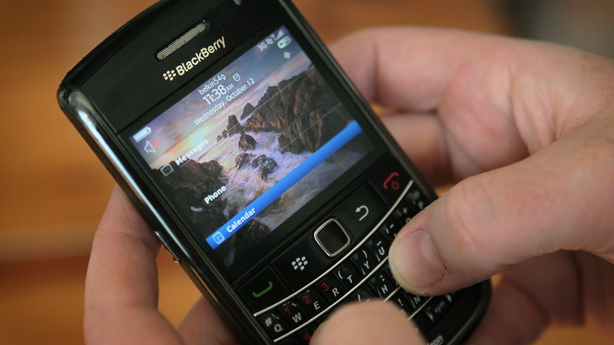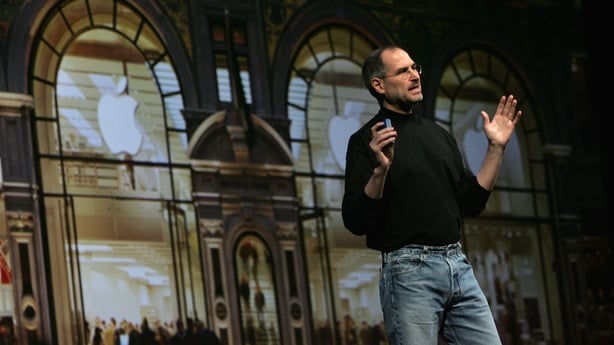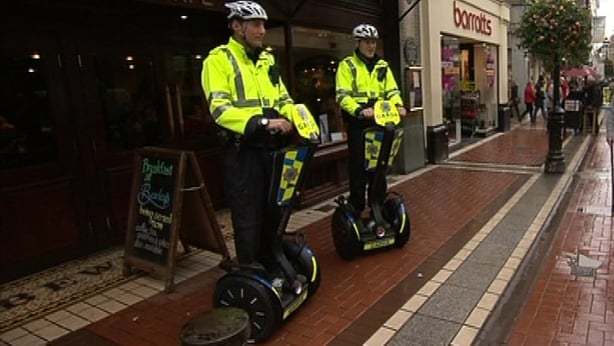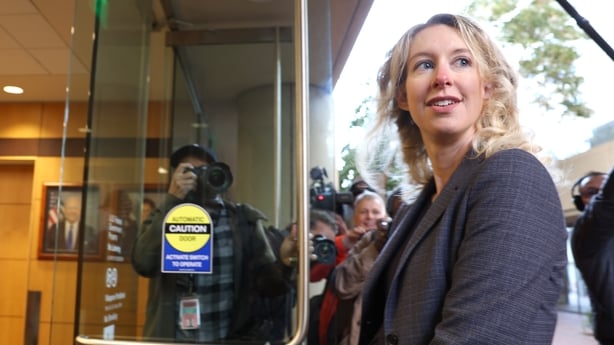Spare a thought for the one-time (paper) billionaire John Foley.
In an interview with New York Post, the co-founder and former CEO of Peloton claimed he had lost all of his money.
Speaking in the context of his new, online rug venture, he told the newspaper he was working hard to make money again because he doesn't have much left.
His new-found hardship has seen him sell his home in the Hamptons, and his Manhattan townhouse – for a combined $86m.
But whether had actually lost all of his money is questionable, though.
He was CEO of Peloton for 10 years – earning millions in salaries and bonuses in that time.
Between 2022 and 2023 he also sold at least $150m worth of Peloton stock.
But whether he is now actually broke, or just quite rich (as opposed to very, very rich), what has changed for him is that he is no longer a member of the billionaire club.
So what happened?
We need your consent to load this rte-player contentWe use rte-player to manage extra content that can set cookies on your device and collect data about your activity. Please review their details and accept them to load the content.Manage Preferences
Foley co-founded and managed Peloton from 2012 until 2022.
For those unfamiliar with the company, its core product is essentially a smart stationary bike which has a sensors tracking your activity levels. It also has a screen attached at the handle bars, which lets you join live classes while you exercise.
But it is very much a premium product.
Today, a Peloton bike costs between €1,900 and €2,700 – quite a mark-up on the €150-200 you’d pay for an entry-level stationary bike.
In order to make full use of its features – including partaking in those live classes – you also need to pay a €40 monthly subscription fee.
But that kind of pricing didn’t discourage the world’s wealthy or sporting elites and in its early years it built up a roster of big-name users.
That includes David Beckham. Rory McIlroy, Michael Phelps, Roger Federer, Beyoncé, Sporty Spice and Hugh Jackman to name just a few.
And those big-name users helped it to draw a lot of investor interest, too.
That ultimately led it to float in 2019, at a valuation of $8.1 billion.
And then the pandemic hit…
An early investor in Peloton must have left like they’d won the lottery when the pandemic hit.
As bad is it was for most businesses, Peloton was one of the few that saw a huge up-side to Covid lockdowns.
That’s because there was suddenly a lot of people stuck at home, unable to get to their gym or sports club.
They were still working but not able to socialise or take holidays – giving them a lot of disposable income. And they had a lot of time on their hands, too.
Suddenly spending thousands of dollars on a stationary bike to help get (or keep) them in shape did not seem like such a bad deal.
So Peloton’s sales boomed – and so did the share price, which pushed the company’s value as high as $45 billion at one stage.
And Peloton reacted to this in a way that a lot of companies do – it began to expand aggressively.
It increased its staffing levels, and it started to push out new products – including a smart treadmill.
But of course it was a critical error to assume that its Covid sales boost was the new reality – rather than just a blip.
Sure enough, when restrictions started to ease – and gyms started to reopen – sales started to fall.
That alone might have been manageable – but more serious problems quickly began to mount.
The treadmill product that it brough to market – called Tread – had no cover on its back end, which prompted safety concerns.
Sure enough, reports began to emerge of pets and even children being pulled under the machine – with one 6-year-old child dying after being injured by the Tread.
The company paid a $19m fine over that case and, in April 2021, the US Consumer Product Safety Commission advised people to stop using the Tread.
In May the company recalled the product altogether.
Did it re-launch the product?

Yes – it brought out a new version of the Tread in August 2021, with added safety features.
But just as it was trying to get back on track, it was hit with another PR nightmare.
This was a far less serious one but, with its problems hitting one after another, it was perhaps even more damaging to the brand.
In a December 2021 episode of 'Sex and the City’ follow-on, ‘And Just Like That’, Samantha’s perennial love interest Mr Big was seen using a Peloton bike.
In the scene he finishes his exercise, gets off the bike, has a massive heart attack and dies.
Needless to say, this was not product placement by Peloton.
The company scrambled to try to do some damage control – it quickly put together an ad featuring John James Preston (the actor who plays Mr Big) which emphasised the importance exercise has in improving heart health.
But the damage was done – and by February of 2022 it was announced that John Foley was leaving – and 2,800 jobs were to go with him.
Barry McCarthy took charge – but things still don’t seem to be going smoothly for the firm.
Back in May it was announced that he was to step down, with 400 more jobs being cut.
And all through this time the share price has been falling – the company is now valued at around $1.8 billion, which is less than a quarter the value it floated at back in 2019.
Are there other boom and bust companies?

Yes – one company was briefly the king of the smartphone market – but it essentially got wiped out by one keynote address.
Founded in 1984, Research in Motion, or RIM – was a pager-maker in its early days.
In the 90s it developed a two way pager – kind of like a texting machine – which was quite novel.
But it was its innovation in the late 90s that really made a difference for the company – because it figured out a way to send and receive emails over a mobile network.
Until then mobile networks couldn’t handle that amount of data – but RIM found a way to make it possible.
In 2002 it launched the BlackBerry 5810 – which can really be seen as a precursor to the smartphones we use today.
It had a large screen, a full keyboard, it could make and receive calls, texts, emails and even offered some basic web browsing.
And BlackBerry quickly became a status symbol for business elite and the go-getters – Mr Big almost certainly used one.
It became a joke how users were addicted to using them – they were dubbed CrackBerries – and at its peak it held a 50% share of the American smartphone market, and a 20% share of the global smartphone market.
Granted, the smartphone market was a lot smaller then than it is now – at the time most regular consumers were using ‘dumbphones’ from the likes of Nokia.
But having such a grasp on the smartphone market should have put RIM in a great position to benefit once people began to embrace the more complex devices.
So what went wrong?

Well it was all going fine for Blackberry until the 9th of January 2007.
That was the day that Apple CEO Steve Jobs took to the stage and unveiled the iPhone.
Blackberry – like Nokia – initially dismissed it. They didn’t see what Apple was doing as a threat.
RIM laughed at the iPhone’s lack of a physical keyboard. They said the email link wasn’t secure enough for business users to trust it. And they said the battery life was crap – which it was.
But it turned out that business users – like consumers – didn’t care about any of that. The iPhone was suddenly the status symbol device.
Other high end touchscreen phones from Samsung, LG and HTC started coming to market shortly afterwards, and Blackberry’s sales began to plummet.
The did belatedly try to bring out their own touchscreen models after a while – and even a few hybrid models that had a keyboard and a touchscreen – but it was too late.
Having been valued at $67 billion in 2007, it sold for $4.7 billion just six years later.
It stopped making its own phones in 2017 – and now Blackberry is a security software company.
What about Segway?

Segway was briefly an iconic product that offered a glimpse into the future. A future that, it turned out, would never happen.
The device was based on a patent filed by Dean Kamen – which was initially used in a self-balancing wheelchair called the iBOT.
But he then began to work on a non-medical application, and the two-wheeled Segway that people know today was launched in late 2001.
It’s hard to overstate the level of hype this device received. May saw it as the future of personal transportation.
Apple boss Steve Jobs said the technology was as big a deal as the PC – and suggested future cities would be built around it.
There were suggestions they would become the go-to transportation devices for police forces in cities, and there were some forces (including An Garda Síochána) that launched pilot schemes with them.
And as people might remember, it quickly started popping up all over TV and film.
And all of that buzz and coverage might have led people to believe that the Segway was quickly becoming ubiquitous… but that was far from the truth.
Initially Segway aimed for 40,000 sales per year. Two years after launch it had only sold 6,000 units.
Five years after launch it was less than 24,000 units.
A big part of the problem was the price – it launched at $5,000 a piece, which is really car-price territory.
But it had an image problem too.
Having raved about it before launch, Steve Jobs later complained about how ugly it was.
And it quickly became a bit of a punchline – it ended up being used by security guards in shopping centres, rather than police forces.
Hot on the heels of the release of ‘Paul Blart: Mall Cop’ in 2009, the company was sold to British millionaire Jimi Heselden.
His plan was to finally get the company to live up to its potential, but it ended tragically.
Less than a year after buying the company, he died after accidentally driving a Segway off a cliff.
Ultimately the brand was acquired in 2015 by a Chinese company Ninebot – now the name is used for scooters and hover-board type devices, as well as robot lawnmowers.
What about Theranos?

This is perhaps the most incredible boom and bust company – because the entire lifecycle existed in the investment world.
It never really became an actual, consumer-accessible product.
Theranos was founded in 2003 by Elizabeth Holmes, the daughter of an Enron vice president, and a Stanford drop-out who claimed to have made an incredible discovery.
She claimed to have created a device that could run a wide array of tests, immediately, with just a small drop of a patient’s blood.
As it stands, getting blood tests usually involves a vial being taken – with multiple tests requiring multiple vials. It tends to take time to get results too.
So the idea that you could do it all, instantly, with one drop of blood – and that you’d have these machines in your local pharmacy – was revolutionary.
Holmes was none to shy about talking up the potential benefit this technology could bring – allowing people to identify and deal with health issues before they became life-altering or even deadly.
And it was such a compelling promise that Holmes managed to drum up $724 million in investment – giving the company a $10 billion valuation.
She had some big names in that investor list too – including Rupert Murdoch, Carlos Slim, Larry Ellison, and the Walton family, who created Walmart.
US pharmacy chain Safeway also spent $350 million to retrofit its stores so they could accommodate these testing machines.
And she even got some heavy hitters on the board – including US Army general Jim Mattis, Henry Kissinger, and US Senators Sam Nunn and Bill Frist.
You’ll notice, though, that they’re all political and military figures – there weren’t many medical or scientific experts keeping tabs on the company.
That was a bit of a tell about what was really going on, because it turned out it was all a lie.
The ‘Edison’ machines that claimed to run these tests never worked.
In what were supposed to be trials, the company would instead run tests using traditional Siemens machines (making excuses to patients to explain why they needed more than a drop of blood).
Then vice president Joe Biden toured the facility in 2015 – but what he was shown was fake, too.
It later transpired that the company had constructed a fake lab for the tour – because their real facility was in such a state of disarray.
And it was around 2015 that people in academia began to ask questions about the technology.
Shortly afterwards the media began to take a closer look, followed by the US FDA.
The lawsuits started piling up, and in September 2018 the company was shut down.
Holmes and her former president Ramesh Balwani were indicted on claims of wire fraud, and they were both, separately, found guilty in 2022.
Holmes was sentenced to more than 11 years in prison, and Balwani was sentenced to almost 13 years.







